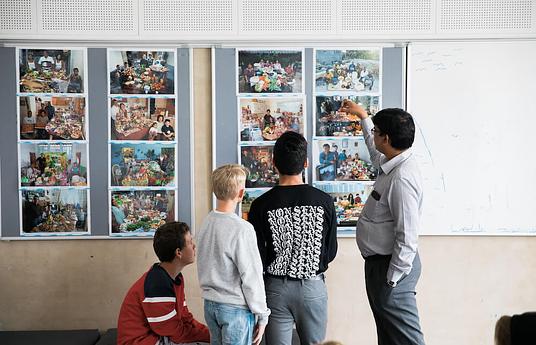Education reformers are not suffering from a lack of promising ideas, but they often struggle to make those ideas work in practice. Educationalists have long sought an elusive “secret sauce” for implementing sustainable reforms. They point to innumerable cases of stalled educational change, which waste precious time, resources, and—most troublingly—human potential. The good news, however, is that education innovators do not have to reinvent the wheel; there is much to learn from the struggles and successes of their peers around the world.
In a cross-country investigation to uncover a “secret sauce” for implementing sustainable education reform, we explored the reform journeys of three nations—Finland, Portugal, and Canada—by asking one thorny question: what are the greatest barriers to, and the key enablers of, sustainable education reform? Analysis of expert interviews and diverse documents revealed five common barriers and three enabling actions, depicted below.
This research began as an advisory project for the Delhi Ministry of Education, which recently launched its ambitious Happiness Curriculum. Leaders were particularly concerned with buy-in and resistance, given the scope and scale of this transformation. Implementing Education Reform began with these concerns in mind, analyzing both the countermeasures that might help leaders unstick resistance, as well as the tenets for building a reform plan that inhibits such resistance in the first instance.
Five clear themes for overcoming and preventing resistance emerged across all cases. Beginning with the most common, these were values, practicality, communication, agency, and leader capacity. We dive into these ideas below.
Crucial Enablers of Sustainable Education Reform
Defining and aligning collective values
Unsurprisingly, values topped the chart of mechanisms driving sustained educational change. Consistently, data highlighted the importance of defining a shared purpose for reform efforts—having a coherent “why.” This always began with a community discussion of societal and educational challenges to develop a collective problem statement. And it regularly relied on cross-sector insights, such as global data on best practices or skill demands, to solidify reform urgency and rationale.
Demonstrating practicality
Actions related to reform practicality were central to driving change. These most often took three forms: building reform evidence, demonstrating technical practice, and showing alignment with existing behaviors. Building and publicizing reform evidence was the most commonly discussed enabler.
Facilitating dialogic communication
Communication was the third-most discussed reform driver, with a particular focus on enabling dialog and debate. Showing up, listening, and engaging allowed leaders to develop an empathetic understanding of local challenges to practice – as well as to identify entrenched beliefs. They could then use that knowledge to open the door for productive discussions to overcome resistance.
Fomenting local agency
Reform leaders also discussed impressions of agency as a key reform enabler. Principally, this was a matter of identity; those implementing reforms needed to see themselves as being experts in their respective domains. Critical involvement bred buy-in by positioning reformers and implementers on the same side of the table. Local agency was not only a method for precluding resistance, ensuring all actors had skin in the game, but also a tool for overcoming emergent blockages; it fostered a cohort of local champions who could work with resisters as trusted peers.
Building leader capacity
Finally, policymakers regularly highlighted leader capacity as central to sustainable change. Reformers focused first and foremost on the capacity of school and teacher leaders, to whom they regularly referred as “risk-takers'' and “culture-setters.” This was, in part, a functional decision, following the time-tested cascading, train-the-trainer model of capacity development – amplifying reach by focusing on those who could replicate and pass on knowledge. But it was also an ideological matter: leaders were at the vanguard of change, nurturing mindset shift by example.
This capacity-building enabled a common process of scaffolded localization. Change began by leaning on prescriptive rules and procedures, then gradually made room for experimentation over time; when reformers noted inconsistency across networks, they reintegrated a more structured vision of reform.
The above enablers combine to highlight three enabling actions for sustainable education reform:
- All actors in a system must define and align collective values: These values reflect a coherent problem statement and rationale for education reform. This can be accomplished only through participatory policy design methods, such as dialogic communication across all levels of the education community.
- Governments must demonstrate reform practicality: This involves building evidence to show that the reforms work, modeling practice to show how the reforms work, and exhibiting alignment between new and existing practices – to prove the reforms are neither a total departure from current learning nor an excessively heavy lift.
- Ministries must cultivate local agency: Specifically, this requires a focus on building local leadership capacity, with the idea that leaders are front-line culture-setters whose beliefs and behaviors guide collective action. It also entails empowering educators – valuing them as the experts best suited to develop and adapt interventions for their own classrooms.
These insights form a reflective checklist for educationalists across the globe to overcome and prevent resistance to educational change. With values, practicality, and agency at the forefront of reformers’ minds, they can craft thoughtful, enduring policies that prepare all children to thrive.
Download the full report for free from Dream a Dream: Implementing Education Reform: “Is there a Secret Sauce”? by Adam Barton.



